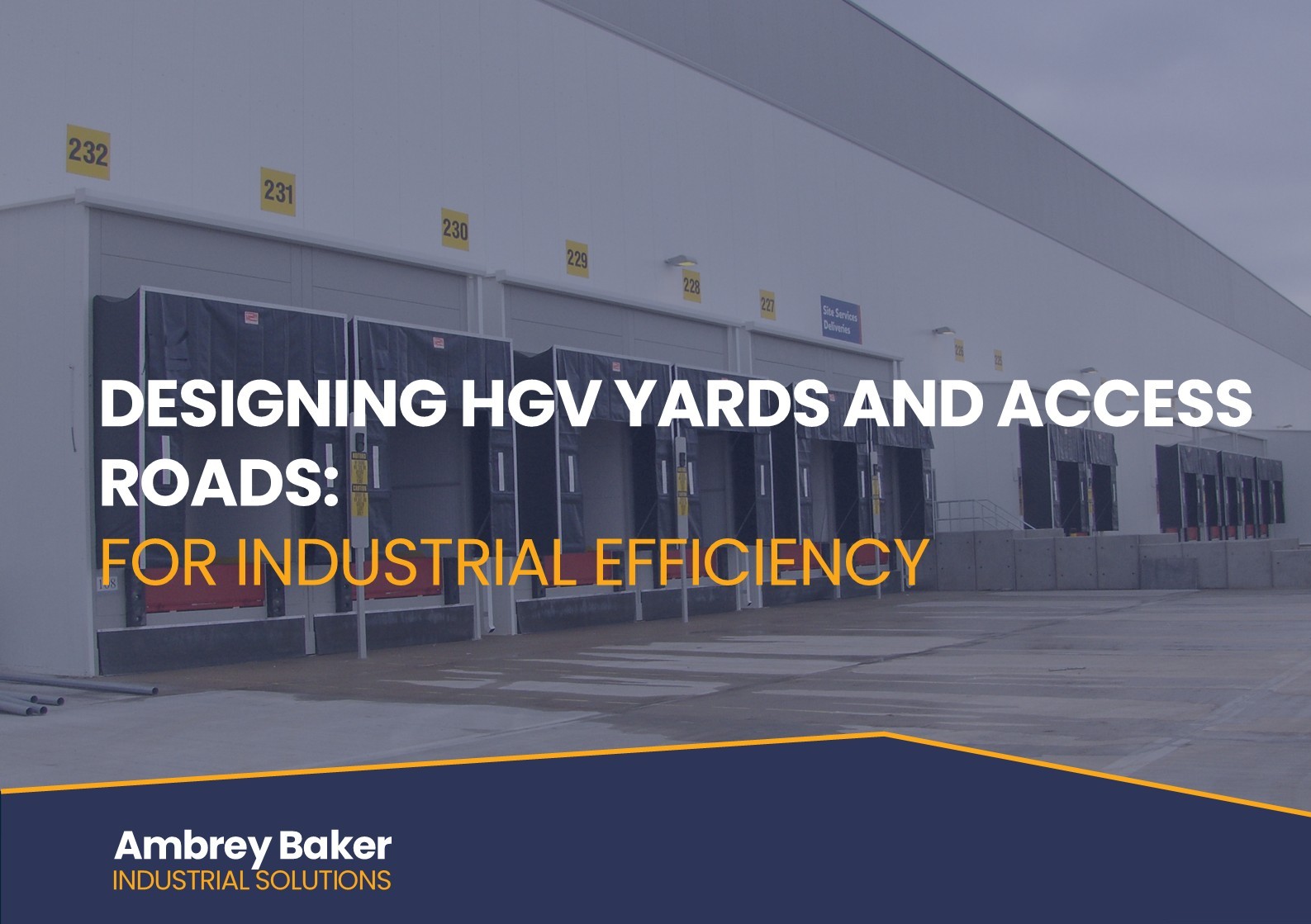Designing HGV Yards and Access Roads for Industrial Efficiency
Industrial facilities operate at scale and speed. Whether distributing chilled food, producing pharmaceuticals, manufacturing high-value components, or storing hazardous chemicals, they rely on a constant flow of heavy goods vehicles (HGVs) to keep supply chains moving. As UK Gov highlighted, road haulage accounts for over 80% of domestic freight transport in the UK. For operators, that reliance on HGVs makes the design of yards and access roads a critical factor in industrial performance. These external works are not just supporting features; they dictate how safely and efficiently vehicles can move, dock, and exit, directly shaping operational cost, safety, and productivity.
The starting point is movement. Vehicles must enter, manoeuvre, dock, and leave with minimal delay. This demands layouts designed around the largest vehicles expected on site, often articulated lorries up to 16.5 m long. The HSE specifies that access routes should routinely be at least 3.5 m wide, acknowledging that they must accommodate wide materials-handling equipment and heavy commercial vehicles. At Ambrey Baker, we prioritise precise site planning by ensuring that all access routes, gradients, clearances, and manoeuvring areas are designed to the latest industry guidance, safely accommodating large goods vehicles. Our approach reduces bottlenecks, enhances traffic flow, and supports efficient logistics operations across every industrial site we deliver.
Safety is equally fundamental. HGV yards are not just for vehicles; they are also workplaces for drivers, pedestrians, and loading staff. The HSE highlights workplace transport as one of the highest-risk activities in UK industry. Vehicle–pedestrian collisions remain a leading cause of serious incidents. To reduce risk, good yard design separates flow wherever possible, using barriers, crossings, and controlled access to loading areas. Adequate lighting is vital for sites operating around the clock, particularly in winter. For facilities handling chemicals, surface grading and drainage must also act as containment systems, preventing spills from contaminating soils and watercourses.
Durability underpins performance. Unlike standard roads, HGV yards experience intense, repeated loading from heavy axles and constant turning movements. Ordinary asphalt designed for cars will quickly fail, leading to rutting, cracking, and potholes that disrupt operations. The Design Manual for Roads and Bridges (DMRB) provide technical standards for yard slab under heavy loading. In practice, reinforced concrete slabs or heavy-duty asphalt over engineered sub-bases are the most common solutions. Drainage must also be designed to prevent water build-up, which accelerates deterioration and creates safety hazards. On food sites, poor drainage can also compromise hygiene standards.
Capacity is another element of efficiency. Logistics research shows that queuing and idling in yards can account for a significant proportion of truck operating time in poorly designed facilities. Designing sufficient queuing space, multiple docking positions, and smooth traffic circulation ensures predictable flows and reduces congestion. For food and pharmaceutical facilities with strict delivery windows, efficient yards protect compliance as well as productivity. In advanced manufacturing, where just-in-time supply chains leave little room for delay, a blocked access road can disrupt entire production schedules.
Resilience is now central to industrial design. Climate pressures-from flooding and freeze-thaw cycles to extreme heat, are increasingly testing infrastructure. The Institution of Civil Engineers highlights resilience as a defining responsibility for civil engineering. For industrial yards, this means specifying frost-resistant materials, installing robust drainage systems, and detailing slabs to prevent ponding. In temperature-controlled and food environments, resilience also covers hygiene: surfaces must be easy to clean and resistant to bacterial growth, with gradients that direct wash water safely to drains.
Adaptability is just as important. Few industrial sites remain static. Distribution centres expand their dock capacity, manufacturers add new production lines, and automation alters traffic flows. Yards built with modular layouts, expansion space, and careful service routing can adapt to these changes without expensive reconstruction. This flexibility supports long-term productivity and aligns with the UK’s industrial strategy for sustainable growth.
Construction quality brings everything together. Even the best design can be undermined by poor workmanship. Compaction, Slab thickness, and joint detailing must all be delivered as specified. The ICE promotes the observational method-monitoring works in real time and adjusting to ground conditions. This approach helps ensure that design assumptions hold true in practice. For facilities operating 24/7, quality control is non-negotiable; unplanned shutdowns for yard repairs can disrupt supply chains, increase costs, and damage customer confidence.
At their best, HGV yards and access roads are not passive infrastructure but active enablers of industrial efficiency. They allow vehicles to move predictably and safely, protect workers, withstand decades of heavy use, and adapt to evolving business needs. When designed in line with UK Gov planning policy, HSE safety standards, DMRB technical requirements, and ICE resilience principles, they provide the durable external works that modern industry depends on.
If you are planning or upgrading an industrial facility, investing in well-designed yards and access roads is one of the most effective ways to improve performance. At Ambrey Baker, we deliver external works that bring safety, efficiency, and resilience together. Get in touch to find out how design can support your next project.











